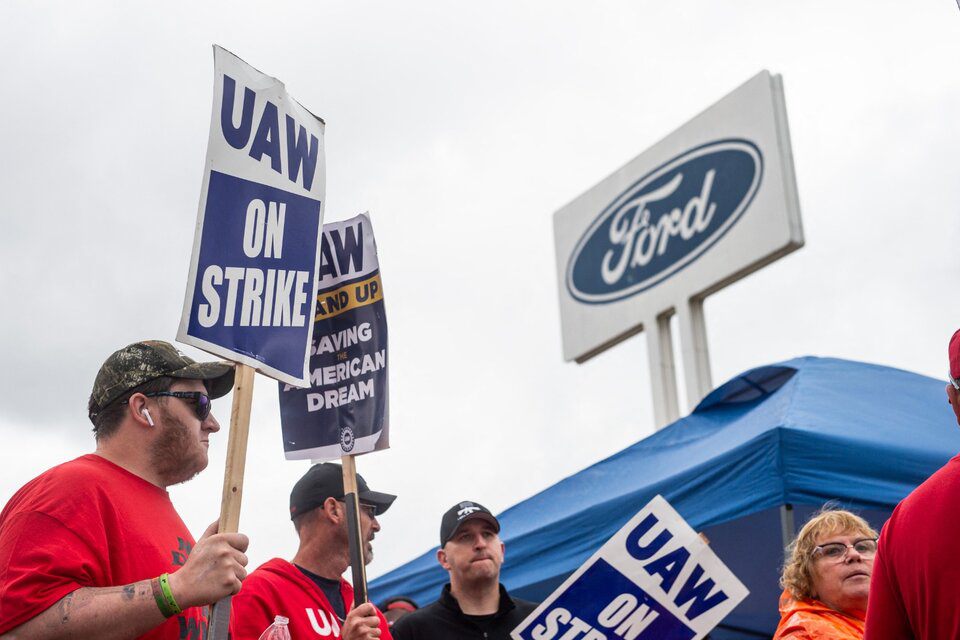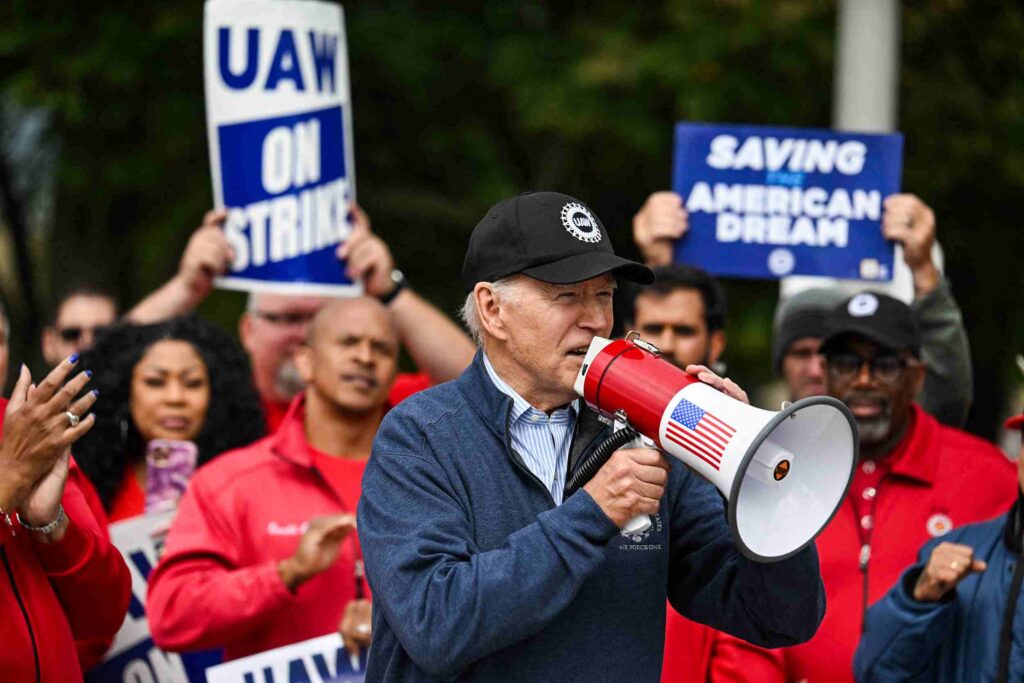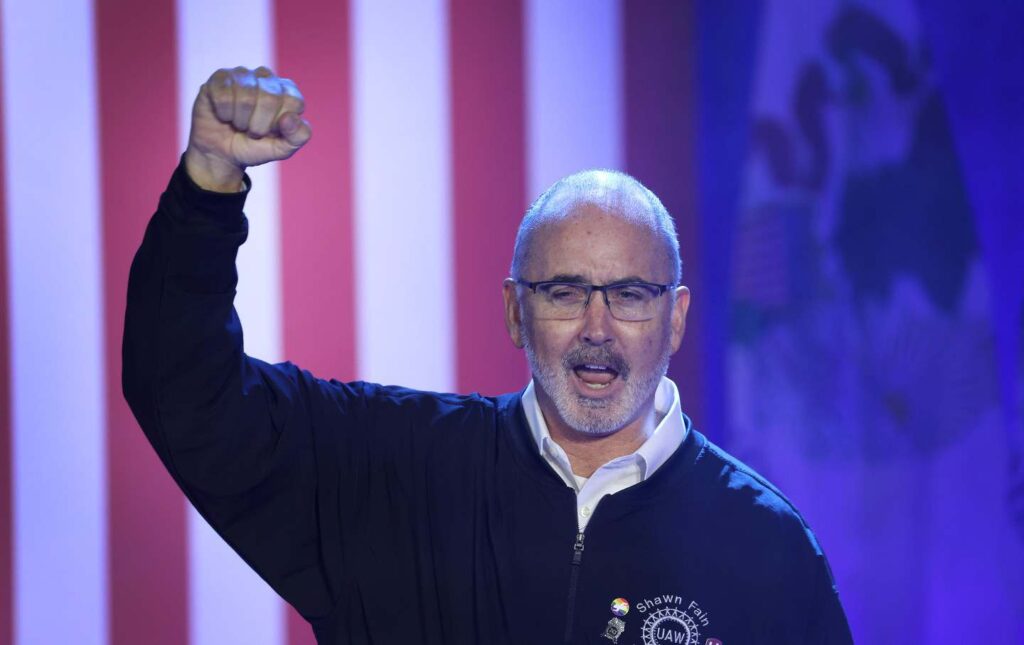Tras una serie de huelgas contra los tres grandes del sector (Ford, General Motors y Stellantis), el sindicato de trabajadores automovilístico estadounidense UAW aprobó los nuevos convenios colectivos, alcanzando una primera gran victoria luego de décadas de confrontaciones diluidas: 146.000 trabajadores sindicalizados elevarán los salarios con aumentos y ajustes por costo de vida, entre otros beneficios. Una movilización histórica que sentó las bases de la lucha obrera.
Por Carolina Menéndez Trucco
Vale la pena hacer huelga. Luego de nueve semanas de protesta, los miembros del sindicato United Auto Workers (UAW) han dado su respaldo a nuevos contratos con los tres grandes fabricantes de automóviles estadounidenses, acuerdos que generan fuertes aumentos salariales y otros beneficios eludidos durante más de 20 años. General Motors, Ford y Stellantis finalmente ratificaron el convenio colectivo que puso fin a la huelga. En la votación más reñida, GM obtuvo el apoyo del 55 % de los casi 36.000 afiliados que votaron. En el caso de Ford, la hoja de cálculo de seguimiento arrojó una mayoría (68,2 % ratificaron el acuerdo de los 34.657 votantes) y en Stellantis votó a favor del acuerdo un 68,4% de 26.289 personas. Los acuerdos firmados por las tres compañías han tenido un efecto extendido sobre otras empresas automovilísticas en Estados Unidos. La movilización que comenzó la medianoche del jueves 14 de septiembre no sólo implicó “una pulseada clave” para el sector, también expandió el alcance al resto de la clase trabajadora.

“Hemos luchado por concesiones que nadie hubiera creído posibles”, afirmó el jefe del UAW, Shawn Fain, sobre el acuerdo preliminar del nuevo convenio colectivo. Si bien la exigencia original había sido un aumento del 40% (la misma cantidad que aumentó el salario de los patrones en los últimos años) y los empleados de más antigüedad no lograron tantas mejoras como los nuevos, los convenios alcanzados implican subas de más del 30% de los salarios en cuatro años y medio, junto a otras mejoras de condiciones laborales, garantías de empleo y nuevos derechos. El dirigente sindical tuvo que apelar a argumentos combativos: al esgrimir los beneficios récord de las empresas y los sueldos multimillonarios de sus directivos, Fain sustentó el motivo de las huelgas, validando la lucha salarial.
Todas las ruedas están quietas…
Las líneas de producción se habían parado desde el 14S a la medianoche. Por primera vez en su historia, el tradicional sindicato automovilístico libraba simultáneamente un conflicto laboral contra las tres principales empresas del sector en Estados Unidos: General Motors (GM), Ford y Stellantis, antes Chrysler. Una semana después de que comenzara la protesta, el sindicato amplió la huelga de tres a 38 plantas.
A medida que avanzaban las negociaciones, el reclamo se hizo más fuerte: a pesar de los temores de que una huelga prolongada “afectaría la economía”, los trabajadores continuaron luchando por mejores salarios en un momento en que las empresas automotrices reportaban mayores ganancias. “¡Sin acuerdo no hay ruedas!”, coreaban los trabajadores cuando el actual presidente del país llegó a un almacén de distribución de piezas de recambio de General Motors.
Una visita inesperada
El momento en que Biden se sumó a la huelga de automotrices: “Wall Street no construyó este país, la clase media lo hizo y los sindicatos construyeron a la clase media”. Bastante lejos de poder ganarse el puesto de compañeroo socio fiable para la clase obrera, Joe Biden es el primer presidente de EE.UU. que se une en persona a trabajadores en huelga. Con un megáfono, una gorra del sindicato y en ropa sport, el líder del Partido Demócrata se dirigió a los huelguistas: “Ustedes salvaron la industria automotriz. Hicieron un montón de sacrificios. Las empresas estaban en problemas. Ahora les va increíblemente bien y, sepan qué, a ustedes también debería”, dijo entre aplausos. Reconociendo a su vez que “han ganado muchísimo más de lo que están siendo pagados”, por lo tanto, merecían un aumento salarial del 40%.

Incluso si Fain no ha respaldado a Biden hasta ahora, ha elogiado su aparición en la manifestación del UAW en Michigan y no sería errado esperar alguna respuesta de parte del sector. En varias ocasiones, el presidente ha afirmado que las compañías automotrices no han hecho lo suficiente para cumplir con las exigencias del sindicato, sobre todo luego de hacer concesiones tras la crisis financiera de 2008. El inédito gesto de Biden se debe no sólo a la fuerza de la huelga, sino también a su necesidad de buscar el apoyo de los sindicatos para las elecciones presidenciales del año próximo.

Un triunfo histórico
Aunque hay variaciones entre los diferentes convenios, en todos ellos el aumento es del 25% en la retribución por hora hasta abril de 2028, y que con algunos ajustes por el coste de la vida será de más de un 30%. Los convenios también incluyen mejoras en las jubilaciones, el fin de la segmentación (acortan el período de aplicación de la doble escala salarial), la incorporación de trabajadores temporales como trabajadores de tiempo completo, una semana laboral de 32 horas con un salario de 40 horas y el derecho de huelga en caso de que una planta cierre.
Las mejoras salariales de este convenio son mayores a las acumuladas en los últimos 22 años. Además existe un ajuste por inflación, que había sido abolido tras el crack de 2008. Su reinstalación es uno de los muchos logros que el sector pudo ganar. La huelga del UAW ha sido sin dudas la más importante en décadas. Los acuerdos propuestos marcan un récord para el sindicato, que se mostró bastante más combativo y estratégico durante las negociaciones que en la historia reciente. El triunfo fue un gran paso adelante en la búsqueda de construir un movimiento laboral más amplio y audaz. Con todo, la movilización tiene lugar en un contexto de transición energética que plantea una encrucijada para la clase obrera. El paso hacia los vehículos eléctricos no le depara más que nuevas confrontaciones: si bien el sindicato UAW buscará ahora incluir a trabajadores de fábricas no sindicalizadas, como las de Tesla y de las compañías extranjeras, las plantas de bajos salarios y no sindicalizadas serán un desafío. En la principal potencia imperialista del mundo, en donde crecen las luchas por salarios dignos, por mejores condiciones laborales y por el derecho a agremiarse, el triunfo de los automotrices fortalece a toda la clase trabajadora.




